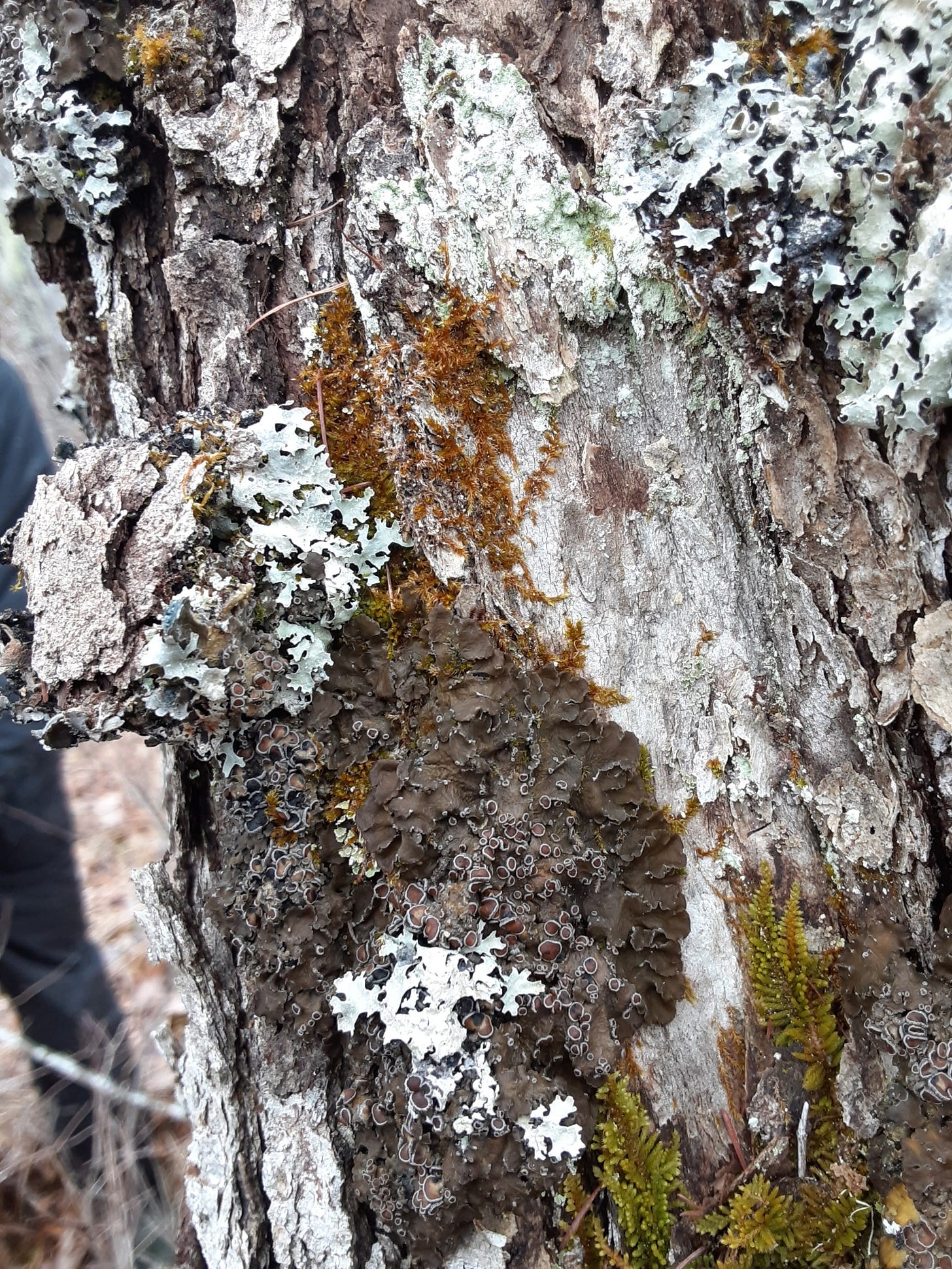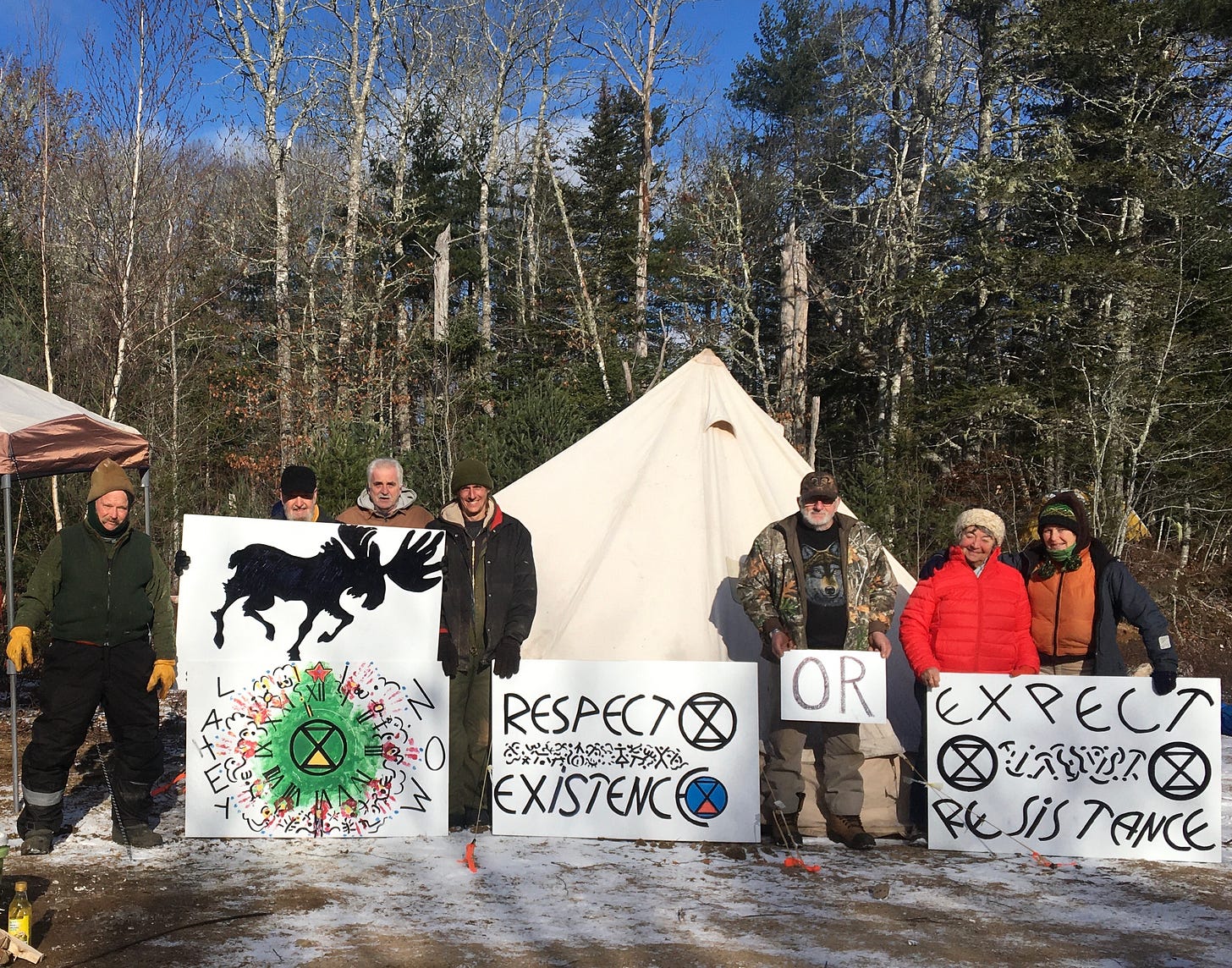Update: Protesters at Last Hope Moose Camp declare partial victory and pack up seven-month encampment
After 202 days of camping out to protect the Beals Brook forest from being logged, a group of protesters led by Extinction Rebellion are announcing “partial victory” today. As was previously reported, the 24-ha parcel of 80-year-old forest on the South Mountain in Annapolis County, Nova Scotia, was slated to be cut late last year by the forest industry consortium WestFor, after receiving approval from the province’s Department of Natural Resources and Renewables (DNRR). But before that could happen, a group mobilized and got in just ahead of the feller bunchers, and have occupied the site ever since.
From the start the group has argued that even though the Beals Brook forest is relatively small, it’s surrounded by a sea of clearcuts, and provides important habitat and a wildlife corridor for species at risk (SAR), including the endangered mainland moose, pine marten, wood turtle, and, as it turns out, several species of rare lichen. In fact, while the old forest has provided the crucial habitat necessary for the rare lichens, it’s the rare lichens that may end up saving the old forest.
“The 17 occurrences of three different Species at Risk lichens discovered in the proposed cut block have put 60% of the original 24 hectares off limits to any disturbance, leaving the remainder hard to access and uneconomical to harvest,” reads today’s press release from the group.
Species at Risk map at the Last Hope Moose Camp indicating the SAR lichen occurrences and their respective 100-metre buffer zones (lime green circles).
You may recall that on Day 56 of the protest — and reported in my earlier piece on this subject — the government announced a temporary “hold” on the plan to log because some rare lichens had been identified at that time in the stand. Black foam lichen, wrinkled shingle lichen, and frosted glass whiskers were located by a lichen enthusiast, and all are designated species at risk.
The DNRR was alerted to the discoveries, and it contracted lichenologist Chris Pepper to visit the site to confirm any/all occurrences and review the surrounding area near the harvest for other potential occurrences. Before the temporary hold on logging could be lifted, 100 metre buffer zones would have to be applied around the trees hosting the rare lichens.
Since then, lichen experts have identified numerous other trees hosting SAR lichens, which have been reported to the DNRR.
Nina Newington is a member of Extinction Rebellion and one of the “forest protectors” who’s been camping out at Beals Brook for the duration. She and the group are hoping the sitings—and the buffer zones that come with them—will make harvesting the site economically unviable for WestFor.
In an email to Newington on April 24, Donna Hurlburt, the manager of biodiversity at the DNRR wrote:
I checked into how things will proceed at this site with respect to new lichen occurrences. Pending confirmation of ID by a qualified lichenologist, department staff will plot the new occurrences and apply the special management practice buffers. After that is complete, they will hand over a revised harvest polygon to WestFor. I understand that WestFor has already been notified that there are likely additional occurrences and to expect a revised polygon.
I reached out to the DNRR and asked if the department plans to suspend or cancel the proposed (but temporarily on hold) harvest given the protesters have located 17 occurrences of SAR lichens that will each require a 100 m buffer zone, significantly reducing the potential harvest area?”
I did not receive a reply in time for publication, but when I do it will be reported here as a postscript.1
In addition to the species at risk, questions are being raised about the potential impact of a shelterwood harvest on the already nutrient-poor soils in the area. The issue of soil “nutrient sustainable” harvests is laid out in this highly informative post (part of a 3-part series about the Beals Brook forest) by retired biology Dalhousie University professor David Patriquin, who has been following the scientific literature and government initiatives relating to nutrient depleted soils and aquatic acidification since 2009.
I asked Newington, without confirmation from the DNRR that the harvest is officially cancelled, how does the group know they won’t just apply the buffers and allow WestFor to go in and log?
It’s a partial victory conditional on us being willing to go back and get in the way of machines and them knowing that. However, anyone who knows anything about commercial forestry thought the original plan was marginal, economically. Now the buffers have reduced the harvestable area to 10 ha and have made access harder. I’m told it makes no sense, money wise, to float in equipment to take 30% of the remainder (plus extraction roads of course.)
Wrinkled shingle lichen ( Pannaria lurida) is one of the rare species located in the Beals Brook forest. According to Frances Anderson: “It’s big and leafy and can colonise a large portion of a tree trunk. It is a cyanolichen, a lichen whose algal partner is a nitrogen-fixer. It's brownish, thick, and is usually fertile, that is, it has fruiting bodies on its upper surface where the fungal spores are produced for reproduction… Found on red maple and poplar on the Atlantic coast, red oak further south and up into Digby county and poplar in Hants. It prefers mature trees, and damp habitats. Photo courtesy: Brad Toms.
Over the last seven months, the Last Hope Moose Camp forest has been a gathering place for forest ecologists, wildlife biologists, species at risk experts, and citizen scientists—all doing the job the government should be: locating species at risk and ensuring they are protected.
Newington says the “big message” of the seven-month protest is that citizens are “stepping up” where “government is failing.” Since the camp has been set up, not one government biologist has “set foot” in the Beals Brook forest, she says.
Government biologists sit behind their desks, signing off on harvests. Ministers hand off decisions to industry. But citizens, working with Indigenous traditional government, are saying no, we do not consent to the ongoing destruction of nature.
“I think we have helped reframe the issue away from clearcutting alone to the more fundamental one: before we even talk about how an area is going to be cut, there needs to be a process for deciding whether the area should be cut at all,” she tells me.
Frances Anderson is a lichen expert and the co-author of the book, Common Lichens of Northeastern North America. Anderson had a significant hand in identifying the species at risk (SAR) lichens at Beals Brook, as well as offering workshops to help train others to do so.
All the at-risk lichens identified in this forest depend on undisturbed, continuous habitat. Given the government's pledge to protect 20% of our lands and waters, we should be saving whatever is left of old forests like this one on Crown lands. There are few forests left on Crown that are over 80 years old - it would be such a simple step for government to save them. This forest and its at-risk lichens would have been lost without the dedication and vigilance of the campers.
While the protesters are leaving the site, they say they will continue to offer workshops there, and if necessary will return to the site.
The workshops will teach more Nova Scotians the skills needed to protect the biodiversity of our forests, from identifying Species at Risk to using free apps to navigate logging roads, identify cut blocks and record information about them.
There is a better way. The Last Hope forest is still standing, still sheltering endangered species. If needed, we'll be back. We know the road.
“Forest protectors,” (in winter) from the left, Keith Joyce, Barrie McGregor, Richard Amero, David Arthur, Tom Amero, Sandra Phinney, Janet McLeod. Photo courtesy: Nina Newington
Here is the answer I received from DNRR on June 22, 2022: “Earlier this year, the department was alerted to several occurrences of rare lichen and placed a temporary hold on the harvest. Since then, all occurrences of lichen reported to us have been reviewed by lichenologists and appropriate buffers of 100 metres have been applied to areas with confirmed sightings. The harvest plan has been adjusted accordingly. Now, the total harvest area is approximately 10ha (25 acres) and approved to proceed at the licensee’s scheduling discretion. The harvest plan aligns with the department’s ecological forestry goals. The prescription is High Retention Gap Irregular Shelterwood with the goal of creating and restoring multi aged forest conditions in this white pine/red oak dominated forest through targeted retention of these species. Once the harvest plan is in place, the licensee is responsible for choosing the timing of the harvest.”






